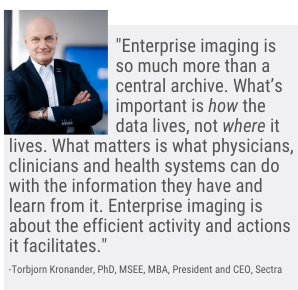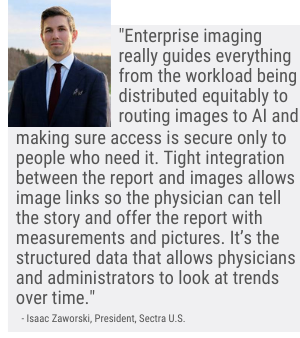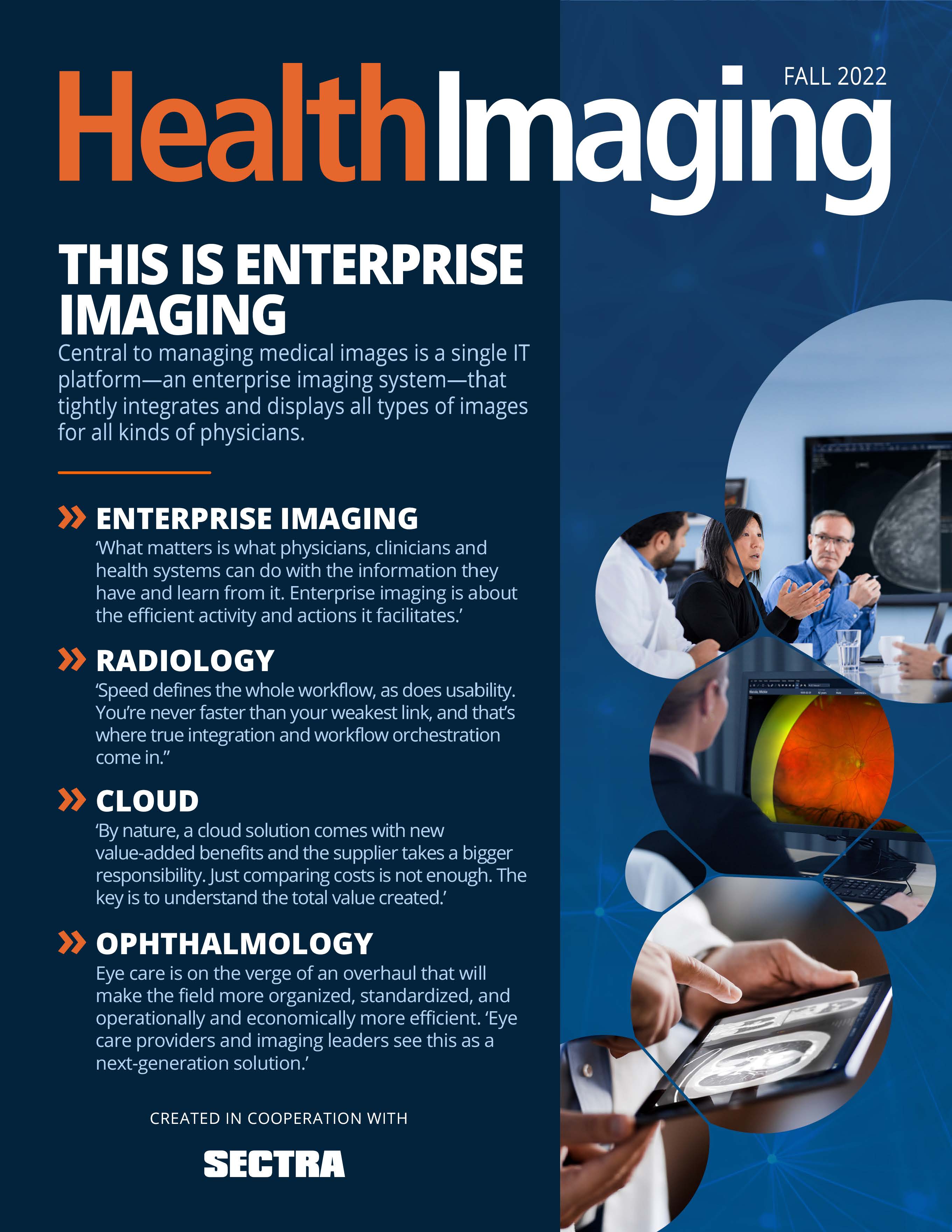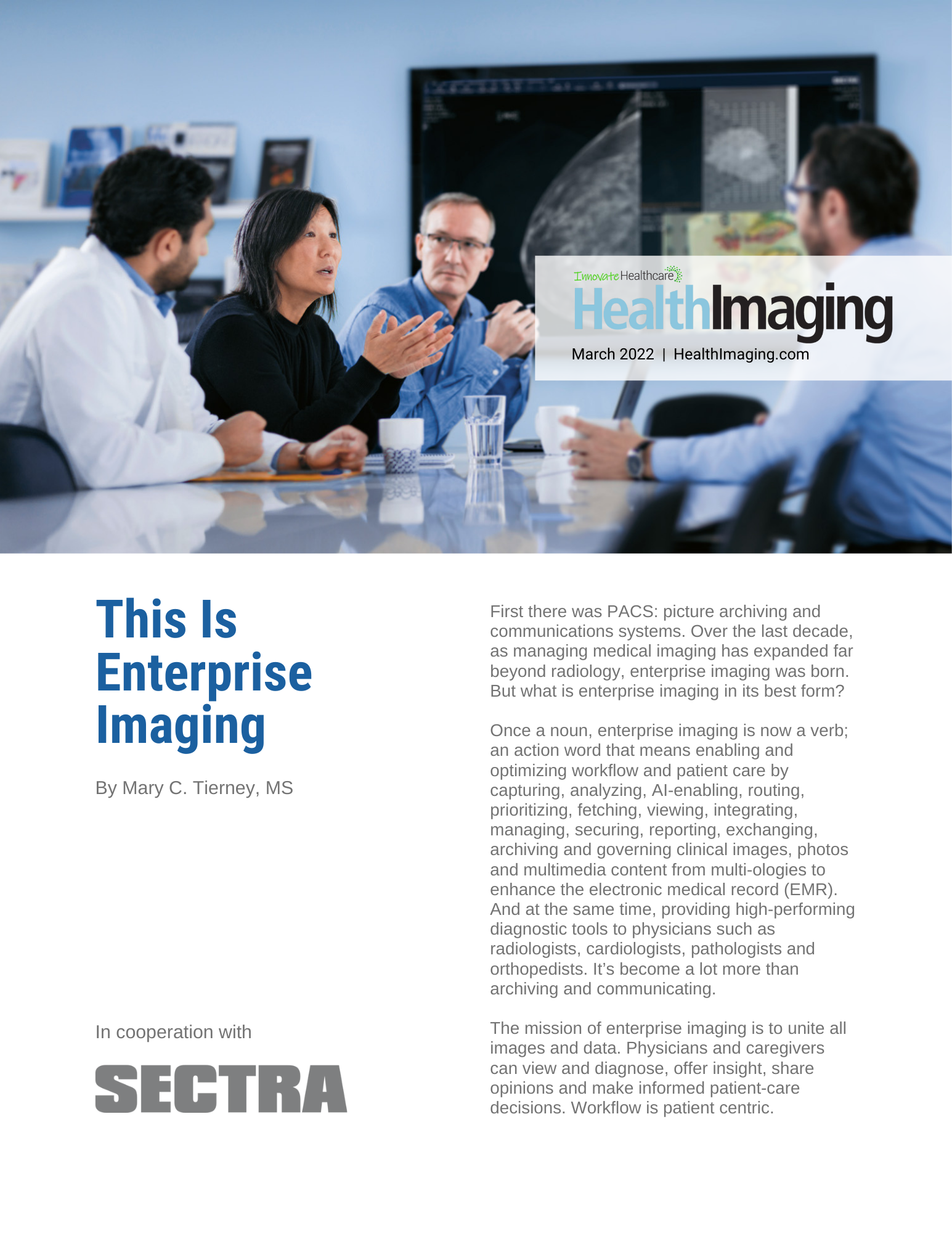This Is Enterprise Imaging
First there was PACS: picture archiving and communications systems. Over the last decade, as managing medical imaging has expanded far beyond radiology, enterprise imaging was born. But what is enterprise imaging in its best form?
Once a noun, enterprise imaging is now a verb; an action word that means enabling and optimizing workflow and patient care by capturing, analyzing, AI-enabling, routing, prioritizing, fetching, viewing, integrating, managing, securing, reporting, exchanging, archiving and governing clinical images, photos and multimedia content from multi-ologies to enhance the electronic medical record (EMR). And at the same time, providing high-performing diagnostic tools to physicians such as radiologists, cardiologists, pathologists and orthopedists. It’s become a lot more than archiving and communicating.
The mission of enterprise imaging is to unite all images and data. Physicians and caregivers can view and diagnose, offer insight, share opinions and make informed patient-care decisions. Workflow is patient centric. Enterprise imaging connects once-separate information siloes across multiple ‘ologies to enhance the entire journey and workflow for physicians and caregivers who need images and access to the EMR to guide decisions on patient care.
In a well-designed IT infrastructure, the EMR can call up enterprise imaging viewers to display images and the other way round. All behave as one seamlessly integrated desktop optimized for individual physician’s needs.
 Central to this is a single IT platform—an enterprise imaging system—that tightly integrates and displays all types of images. Just as the EMR is the source of truth for everything patient data across a health system, enterprise imaging, the “pixel EMR” as some call it, is the source of truth for everything imaging.
Central to this is a single IT platform—an enterprise imaging system—that tightly integrates and displays all types of images. Just as the EMR is the source of truth for everything patient data across a health system, enterprise imaging, the “pixel EMR” as some call it, is the source of truth for everything imaging.
“We’re seeing a similar trend in imaging that we saw many years ago when CIOs wanted to move away from separate information systems such as RIS for each department in the hospital,” says Torbjorn Kronander, PhD, MSEE, MBA, president and CEO of Sectra. “Those systems were expensive and physicians couldn’t get what they wanted from them with any kind of efficiency. The solution turned out to be one EMR for the enterprise with modules for the different departments. Today, healthcare leaders and IT folks tell us the fewer the systems, the better for imaging too. Having many IT systems is complex to manage and very costly to own and operate. It also increases cyber security risks, as no chain is stronger than its weakest link, and all these systems must be secured instead of just one. Health system leaders want to improve accessibility to imaging as they did with EMR data, and thus performance, while reducing complexity, burden on IT staff and definitely, cost.”
Building a foundation
For these reasons and more, an increasing number of health systems large and small have moved from multiple PACS to one enterprise imaging system—or are implementing or planning for a change.
Many enterprise imaging systems today are already integrating radiology, breast imaging, nuclear medicine and cardiology, and increasingly orthopedics, pathology, dermatology and ophthalmology. Some also include endoscopy, mobile apps for POCUS and photographing wounds and burns.
The backbone is either a stand-alone vendor neutral archive (VNA) or a full-fledged enterprise imaging system that manages and stores images in a vendor-neutral format, acting to the outside world as a VNA. The second is the stronger option, says Isaac Zaworski, president of Sectra U.S. “The VNA only stores data and storage is not enough. It's the capturing and storing of data in a structured way, enabling access and getting the data to the end users, and then providing effective workflows in the clinical process, that are critical.”
Think of it this way: All kinds of images need to be indexed the same way in the same system for a physician to be able to access and analyze the full picture of a patient. It is the system that brings all the image data together, cleans, normalizes and hosts it in such a way that it is discoverable and accessible. Linking together that key information in the background differentiates enterprise imaging from a VNA. The enterprise imaging system is the foundation upon which you build everything else because it provides a more comprehensive and more efficient workflow than a VNA approach.
In both instances, images live in a central location in a vendor-neutral format. They include medical images, videos and audio clips. Among those are all types of DICOM images, ECG, HD film, non-DICOM images and whole-slide digital pathology images.
Images may be DICOM-wrapped or kept in their original format so IT teams can choose the optimal strategy for each department and workflow. Since images, and other multimedia, are only stored and accessed using standards such as, DICOM, HL7, DICOM web and XDS, they can be accessed by any standards-compliant application. This helps avoid the need for future data migration projects.
“In a situation where you have all these different data types, the tighter integration of an enterprise imaging system becomes really valuable,” Zaworski says. “It is the tighter integration that enables all of the real-world benefits in an enterprise environment because current data and interface standards are just not there to support it all. Yet, anyway.”
Kronander nods in agreement. “Enterprise imaging is so much more than a central archive,” he says. “What’s important is how the data lives, not where it lives. What matters is what physicians, clinicians and health systems can do with the information they have and learn from it. Enterprise imaging is about the efficient activity and actions it facilitates.”
A positive user experience
On the front end, consolidating multidisciplinary images and multimedia offers more simplified and near-instant access for physicians and caregivers. Workflow orchestration and automated triage, for example, route exams to subspecialized physicians in neuroradiology, musculoskeletal imaging or pathology. Clinical workflow and patient outcomes improve too.
The enterprise imaging system delivers the reading and review tools that various physicians need with each exam. Advanced visualization tools offer native 3D, mammography, nuclear medicine, oncology and orthopedics for specialists who need them. Similarly, native integration within the enterprise imaging system allows for worklist prioritization, automatic lesion detection and CAD marks. Other tools help to speed workflow, namely anatomic linking, lesion tracking, cell counting and/or volume measurements. Instant messaging and chat also are helpful in linking physicians, technologists and nurses—not the least in getting second opinions from ultra-specialized colleagues at other locations.
“The application layer—the end user experience component—needs to be flexible and modular enough so that no matter what the physician’s specialty is the application is tailored for his or her specific needs and workflows,” Zaworski says, “while linking back into the underlying enterprise image management system and EMR.”
Enterprise imaging also delivers AI apps seamlessly embedded within physician workflow, normally through a marketplace delivered by the EI vendor. An open-systems approach allows health systems to choose vendor-supported AI applications that have already been tested, validated, integrated and are vetted as for cyber-security. Collectively, AI apps allow physicians to focus on exams that their expertise brings value to and leave behind tasks computers conquer faster than humans.
“Enterprise imaging really guides everything from the workload being distributed equitably to routing images to AI and making sure access is secure only to people who need it,” Zaworski says. “Tight integration between the report and images allows image links so the physician can tell the story and offer the report with measurements and pictures. It’s the structured data that allows physicians and administrators to look at trends over time.”
The many benefits of enterprise imaging
With enterprise imaging comes a solid strategy for enhancing patient and caregiver experience, improving population health, and reducing complexity and cost. There’s also a commitment to improve quality of care and patient safety as well as reduce of cybersecurity risks of all imaging data.
Informed business analytics, common for all imaging, offer insights and trending, thus driving smart decision-making across health systems clinically, operationally and financially.
For the radiologist, enterprise imaging improves workflow and ensures all images, systems and data are connected. This means access to the full imaging record customized by specialty and the full EMR in one view.
Bringing technology together also brings people together. Decision-making is more informed and lead times tighten from diagnosis to care. Referring physicians and surgeons benefit from deeper access to information and patient care and patient experience is better too.
“A tight integration between all types of images as well as the EMR allows physicians in tumor boards to display pathology, radiology and dermatology images side by side on one system,” Kronander says. “For example, with a breast cancer patient, the physicians can view mammograms, ultrasounds and MRI along with pathology. They are more confident they have all the information they need to make important and often, complicated, decisions. For the patient outcome, that is a large advantage.”
When it comes to educating patients, physicians can pull up all images, videos and multimedia at the bedside or in the office. Patients become partners and shared decision-makers in their own health.
Enterprise imaging also brings productivity surges across caregivers and departments. In moving away from the complexity of maintaining multiple and redundant IT systems, costs can decrease for a long list of things: care, operations, IT staffing, hardware, data storage, software licensing, cybersecurity hardening and services. Server costs can be shared across more departments. EMR integrations can be limited to be between two systems instead of many. Operating costs are often slashed and can be managed in a software as a service model. Think greater simplicity and better outcomes for CIOs and IT staff, better usability for clinical specialists and more flexibility for health systems to acquire new technology without large capital investments.
With fewer and more secure IT access points, risk is similarly reduced thanks to greater data security. Staff no longer worry about putting patches in place ASAP, cyber updates or cyber security attacks. And in some instances, lost imaging revenue can be found by connecting devices to allow billing.
Enterprise imaging moving to the cloud
Enterprise imaging should be ideally implemented in the cloud, but is not necessarily cloud-enabled. A decade from now all systems will include a cloud component because of all the benefits they offer. In a fully managed cloud service, vendors, not IT teams, handle hardware, software, upgrades, scalability and security. That includes taking full responsibility for storage, compute and a guarantee on cost for cloud infrastructure. That allows providers to concentrate on what they know best: taking care of patients.
“By implementing a well thought out enterprise imaging strategy,” Zaworski notes, “you're doing all the legwork to create an architecture that’s prepared to support the future in a way that will be more economical.”
The benefits are powerful now but they’re also paving the pathway for the integrated diagnostic vision of the future: personalized medicine. “How we actually bring the data together and structure it in the context of a whole patient and add in AI is a one-two punch that is going to start to pay dividends for health systems,” he says. “Right now, there’s a massive amount of noise around algorithms trying to outperform humans. That’s never going to show value. But as soon as we all start linking together multiple disciplines and allow the algorithms to search for trends across disciplines, we’re going to start seeing results that we don’t have today. And add to that genomics, proteomics, other heuristic remotely sensed data. This is the real story from an enterprise imaging standpoint. And why a VNA is just an archive that cannot accomplish these benefits. The images, the EMR, structured in one system for all touch-points in a whole patient jacket. This will allow the best view of individual patients and is the building block healthcare needs to push care and research into the future. Enterprise imaging is central to making that happen.”



